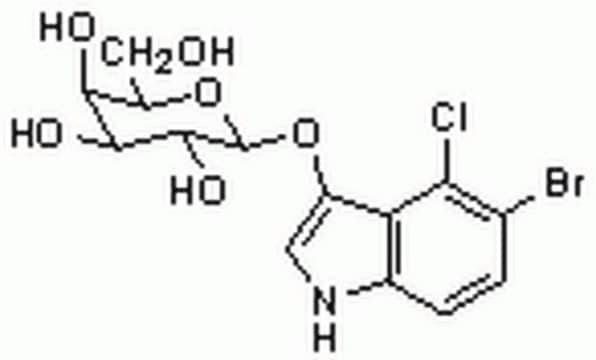B9146
5-Bromo-4-chloro-3-indolyl β-D-galactopyranoside
≥98%, powder, suitable for identification of lac+ bacterial colonies
Synonym(s):
5-Bromo-4-chloro-3-indolyl β-D-galactoside, BCIG, X-Gal
About This Item
Recommended Products
product name
5-Bromo-4-chloro-3-indolyl β-D-galactopyranoside, ≥98%
Assay
≥98%
form
powder
solubility
DMF: methanol (1:1): soluble 50 mg/mL
suitability
suitable for identification of lac+ bacterial colonies
storage temp.
−20°C
SMILES string
OC[C@H]1O[C@@H](Oc2c[nH]c3ccc(Br)c(Cl)c23)[C@H](O)[C@@H](O)[C@H]1O
InChI
1S/C14H15BrClNO6/c15-5-1-2-6-9(10(5)16)7(3-17-6)22-14-13(21)12(20)11(19)8(4-18)23-14/h1-3,8,11-14,17-21H,4H2/t8-,11+,12+,13-,14-/m1/s1
InChI key
OPIFSICVWOWJMJ-AEOCFKNESA-N
Looking for similar products? Visit Product Comparison Guide
Related Categories
Application
Reconstitution
related product
Storage Class Code
11 - Combustible Solids
WGK
WGK 3
Flash Point(F)
Not applicable
Flash Point(C)
Not applicable
Personal Protective Equipment
Certificates of Analysis (COA)
Search for Certificates of Analysis (COA) by entering the products Lot/Batch Number. Lot and Batch Numbers can be found on a product’s label following the words ‘Lot’ or ‘Batch’.
Already Own This Product?
Find documentation for the products that you have recently purchased in the Document Library.
Customers Also Viewed
Articles
General protocols for growth of competent cells and their transformation (uptake of DNA).
Transformation introduces exogenous DNA into cells, a fundamental genetic modification process demonstrated in Streptococcus pneumoniae.
Protocols
Technical Article on competent cells. Transformation is a process by which some bacteria take up foreign genetic material (naked DNA) from the environment.
Yeasts are considered model systems for eukaryotic studies as they exhibit fast growth and have dispersed cells.
General protocols for growth of competent cells in microbial medium.
Our team of scientists has experience in all areas of research including Life Science, Material Science, Chemical Synthesis, Chromatography, Analytical and many others.
Contact Technical Service







